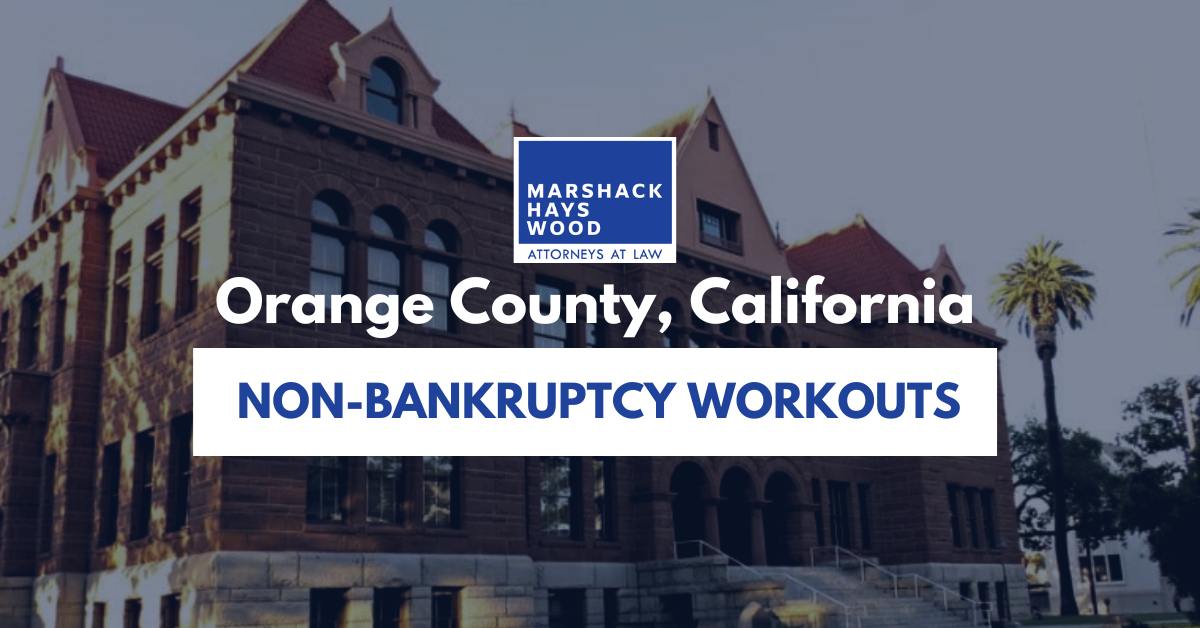Non-Bankruptcy Workout Attorneys in Orange County, California
Home » Practice Areas » Non-Bankruptcy Workouts
Practice Areas
Helping Individuals and Businesses with Bankruptcy Alternatives in Southern California

Given the current state of California’s bankruptcy laws and those of America as a whole, non-judicial debt relief solutions have gained rapid popularity. If you are considering a bankruptcy filing as a debt relief solution, our experienced non-bankruptcy workout attorneys can help you explore viable alternatives that would not be available in your situation. Our Orange County bankruptcy attorneys have considerable experience helping clients with non-bankruptcy workout agreements.
At Marshack Hays Wood LLP, our legal team has successfully structured out-of-court workouts for retail stores and service industries. We recently completed a workout with employees who filed a class-action wage claim. In each instance, the businesses remained open, employees kept their jobs, and creditors were paid a discounted amount over time.
If you’re in need of a skilled team that handles out-of-court bankruptcy workouts, Marshack Hays Wood is here for you. To schedule a consultation with one of our attorneys, please call 949-333-7777 or reach out online today.
What is a Non-Bankruptcy Workout?
Non-bankruptcy workouts offer a private alternative to filing for bankruptcy by allowing debtors and creditors to reach their own repayment agreement. After the 2005 changes to federal bankruptcy laws made formal filings more difficult, these negotiated solutions became more common. Workouts are usually faster, less expensive, and less damaging to credit because they avoid court involvement. They operate as voluntary contracts, which gives the parties flexibility but also means every creditor must agree to the terms. Any creditor can refuse to participate or pursue traditional debtor-creditor remedies instead.
Workouts also depend heavily on timing. Debtors gain stronger negotiating power when they start discussions before missing payments or falling into default. Speaking with our experienced non-bankruptcy workout attorneys at Marshack Hays Wood can help determine whether a workout is realistic and position the debtor for a better outcome.
What is a Workout Restructuring?
Corporate workouts allow companies to renegotiate the terms of their debt with secured and unsecured creditors. Businesses typically pursue these agreements to prevent payment or covenant defaults and to keep financial problems out of public bankruptcy proceedings in state or federal court. Workouts provide a private path to restructuring that helps companies stabilize operations while avoiding the cost, delay, and publicity of a formal bankruptcy filing.
Common Situations That Lead to a Workout Solution
- Temporary cash flow issues
- Vendor or supplier pressure
- Loan defaults or upcoming balloon payments
- Threatened litigation or foreclosure
- Disputes with secured or unsecured creditors

What is the Difference Between a Private Workout and Bankruptcy?
A non-bankruptcy workout gives a company a chance to resolve debt issues privately, while bankruptcy options involve a formal court process with added court costs and strict oversight. Some businesses prefer a workout because it can limit contact with a debt collector and keep financial challenges confidential. In many cases, companies choose this solution first, turning to bankruptcy only when workouts fail or when a structured court process becomes the best option.
Out of Court Workout vs Bankruptcy
The most common differences between creditor workouts and bankruptcy include:
- Overall Cost: If cost is a concern, workouts are generally less expensive than a bankruptcy case. Part of the reason for this is the cost-effective way workouts are conducted. They are faster than bankruptcy filings and involve far fewer legal professionals. Additionally, bankruptcy requires debtors to pay filing fees (unless they are granted a fee waiver). They may even have to pay fees associated with the creditors’ committees.
- Time: Because workouts generally do not involve every single creditor that a company or individual has, these cases are often completed much faster than bankruptcy. Workouts involve a debtor’s major creditors, and they are not bound by the legal proceedings of the Bankruptcy Code.
- Litigation: Filing for bankruptcy triggers what is known as the automatic stay. The automatic stay protects debtors from eviction proceedings, foreclosures, wage garnishments, and any other ongoing litigation. Workouts, however, offer no such legal protections unless the parties involved negotiate forbearance agreements.
- Disruptions: It is important to maintain the daily operations of a company. Filing for bankruptcy is a public action that may cause confusion among customers, employees, and even creditors. Workouts are private discussions between the company and its creditors, which means they shouldn’t affect a company’s operations.
- Equity: It is rare for a company to keep any existing equity unless it meets very strict requirements. However, in a workout, the company is much more likely to retain its existing equity.
- Requirements: Once signed and agreed upon, a workout can only bind the parties involved to the workout specifically. Bankruptcy filings bind all of a debtor’s creditors to the liquidation or reorganization plan.
Types of Bankruptcy Workouts
Workouts generally fall into two categories. These categories are composition and extension workouts. In some situations, the parties may combine features of both. Because a workout functions as a contract, the terms can be customized to fit the debtor’s circumstances and the creditors’ expectations.
- Composition Workouts: Compositions are contracts between a debtor and several creditors in which the creditors agree to partial payments to settle their claims.
- Extension Workouts: Extensions consist of a contract between a debtor and several creditors wherein the creditors agree to extend the time the debtor has to pay the debts owed.
Other Non-Bankruptcy Workout Options
Out-of-court loan modifications focus on working directly with lenders to adjust the terms of existing debt without involving the court system. These negotiations may lead to revised payment schedules, reduced interest rates, or other changes that make repayment more manageable for the business while helping lenders maintain confidence in the recovery plan. An Orange County loan modification lawyer at Marshack Hays Wood can help you explore this debt-relief option – request a free consultation today.
A forbearance agreement temporarily pauses a lender’s enforcement actions, such as foreclosure or repossession, to give the business time to stabilize its finances. During this period, the lender agrees not to pursue collection efforts while the company works to improve cash flow, secure new funding, or prepare a longer-term repayment plan.
Debt restructuring and settlement focus on creating a structured repayment plan that a business can realistically meet. When the company’s financial condition supports it, creditors may agree to reduce the total debt owed. This approach can help the business regain stability while offering creditors a practical path toward recovering a portion of their claims.

Benefits of a Non-Bankruptcy Workout
A non-bankruptcy workout agreement offers several advantages for companies that want to resolve debt problems without entering a formal court process, including:
- More control over repayment terms instead of relying on the mercy of the court
- Ability to meet with creditors in person and negotiate solutions tailored to your needs
- Potential reduction in payment obligations or interest
- Faster, more private process that avoids the last thing most companies want: a public bankruptcy filing
- Opportunity to preserve business relationships through cooperative problem-solving
Do I Need an Attorney for Bankruptcy Workouts and Restructuring?
Although you are not required to have an attorney on your side for out-of-court workouts, we strongly recommend working with an interdisciplinary team of business, bankruptcy, and commercial litigation attorneys. If you are unsure of whether or not a workout is right for you, working with an attorney can ensure that you avoid making any costly mistakes. Your attorney can advise you of the pros and cons of workouts compared with bankruptcy in your specific situation and guide you through whichever process aligns with your best interest.
At Marshack Hays Wood, we have extensive experience representing creditor rights and debtors across Southern California, meaning we fully understand what it takes to achieve a successful workout.
Why Choose the Orange County Non-Bankruptcy Workout Attorneys at Marshack Hays Wood?
Choosing the Orange County, CA non-bankruptcy workout attorneys at Marshack Hays Wood gives clients access to a law firm with the knowledge and experience to assess their circumstances and recommend the most practical path forward. Our team understands that a workout can resolve a portion of the debt owed while avoiding the stigma attached to formal bankruptcy options.
Clients value our prompt communication, and when they call, they get clear answers tailored to the facts of their situation. We focus on strategies that support long-term success and help clients learn which approach will produce the strongest result for their business.
Contact a Skilled Bankruptcy and Business Litigation Lawyer Today
At Marshack Hays Wood, our attorneys have decades of experience handling a number of business and bankruptcy litigation cases. Some examples of issues that we handle include creditors’ rights litigation, Chapter 11, 7, 13, and 9 bankruptcy cases, insolvency, restructuring, and reorganization. Our lawyers will help you stand up to the teams of lawyers that other companies and financial institutions will have at their disposal. To schedule a consultation with one of our attorneys, you can reach us by phone at 949-333-7777 or by completing our online intake form today.
READY TO GET STARTED?
At Marshack Hays Wood, our attorneys provide the legal support you need to move forward with confidence. Let us help you take the first step toward financial stability.
